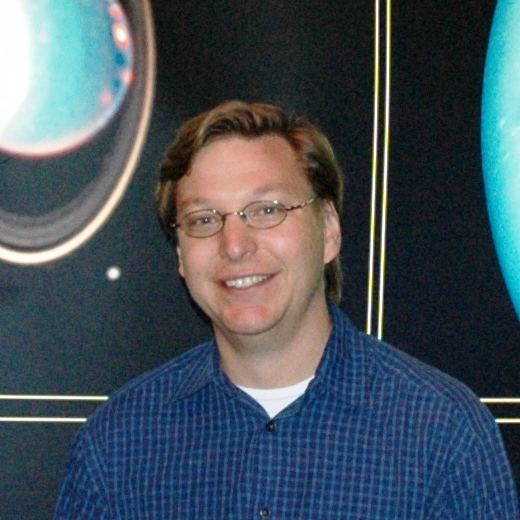Nationality American Spouse Diane Binney (m. 2003) Role Astronomer | Name Michael Brown Fields Planetary astronomy Children Lilah Binney Brown | |
 | ||
Born June 5, 1965 (age 60) ( 1965-06-05 ) Known for Books How I Killed Pluto and Why It Had It Coming Parents Barbara Skaggs, Thomas Brown Similar People Chad Trujillo, David L Rabinowitz, Jose Luis Ortiz Moreno, Jean‑Luc Margot, Eleanor F Helin Profiles | ||
Michael E. Brown
Michael E. Brown (born June 5, 1965) is an American astronomer, who has been professor of planetary astronomy at the California Institute of Technology (Caltech) since 2003. His team has discovered many trans-Neptunian objects (TNOs), notably the dwarf planet Eris, the only known TNO more massive than Pluto. He has referred to himself as the man who "killed Pluto", because he furthered Pluto being downgraded to a dwarf planet in the aftermath of the discovery of Eris and several other probable trans-Neptunian dwarf planets. He is the author of How I Killed Pluto and Why It Had It Coming, published in 2010. He was awarded the Kavli Prize (shared with Jane X. Luu and David C. Jewitt) for 2012 “for discovering and characterizing the Kuiper Belt and its largest members, work that led to a major advance in the understanding of the history of our planetary system"
Contents
- Michael E Brown
- Mike Brown Destroyer of Worlds
- Early life
- Discoveries
- Haumea controversy
- Proposed Ninth Planet
- Other work
- Honors awards and accolades
- Students and postdocs
- Personal life
- References

Mike Brown: Destroyer of Worlds
Early life

Brown is a Huntsville, Alabama native and graduated from Virgil I. Grissom High School in 1983. He earned his A.B. in physics from Princeton University in 1987, where he was a member of the Princeton Tower Club. He did his graduate studies at the University of California, Berkeley where he earned an M.A. degree in astronomy in 1990 and a Ph.D. degree in astronomy in 1994.
Discoveries

Brown is well known in the scientific community for his surveys for distant objects orbiting the Sun. His team has discovered many trans-Neptunian objects (TNOs). Particularly notable are Eris, a dwarf planet and the only TNO known to be more massive than Pluto, leading directly to Pluto's demotion from planet status; Sedna, a planetoid thought to be the first observed body of the inner Öpik–Oort cloud; and Orcus.

Brown's team famously named Eris and its moon Dysnomia with the informal names Xena and Gabrielle, respectively, after the two main characters of Xena: Warrior Princess.
Haumea controversy

Brown and his team also had been observing the dwarf planet Haumea for approximately six months before its announced discovery by José Luis Ortiz Moreno and colleagues from the Sierra Nevada Observatory in Spain. Brown originally indicated his support for Ortiz's team being given credit for the discovery of Haumea. However, further investigation showed that a website containing archives of where Brown's team's telescopes had been pointed while tracking Haumea had been accessed eight times in the three days preceding Ortiz's announcement, by computers with IP addresses that were traced back to the website of the Instituto de Astrofísica de Andalucía (CSIC, Institute of Astrophysics of Andalusia), where Ortiz works, and to e-mail messages sent by Ortiz and his student. These website accesses came a week after Brown had published an abstract for an upcoming conference talk at which he had planned to announce the discovery of Haumea; the abstract referred to Haumea by a code that was the same code used in the online telescope logs; and the Andalusia computers had accessed the logs containing that code directly, as would be the case after an internet search, without going through the home page or other pages of the archives. When asked about this online activity, Ortiz responded with an email to Brown that suggested Brown was at fault for "hiding objects", and said that "the only reason why we are now exchanging e-mail is because you did not report your object." Brown says that this statement by Ortiz contradicts the accepted scientific practice of analyzing one's research until one is satisfied that it is accurate, then submitting it to peer review prior to any public announcement. However, the Minor Planet Center only needs precise enough orbit determination on the object in order to provide discovery credit, which Ortiz provided.
The then director of the IAA, José Carlos del Toro, distanced himself from Ortiz, insisting that its researchers have "sole responsibility" for themselves. Brown petitioned the International Astronomical Union to credit his team rather than Ortiz as the discoverers of Haumea. The IAU has deliberately not acknowledged a discoverer of Haumea. The discovery date and location are listed as March 7, 2003 at Ortiz's Sierra Nevada Observatory. However, the IAU accepted Brown's suggested name of Haumea, which fit the names of Haumea's two moons, rather than Ortiz's Ataecina.
Proposed Ninth Planet
In January 2016, Brown and fellow Caltech astronomer, Konstantin Batygin, proposed the existence of Planet Nine, a major planet between the size of Earth and Neptune. The two astronomers gave a recorded interview in which they described their method and reasoning for proposing Planet 9 on January 20, 2016.
Other work
In 2010 Brown published a memoir of his discoveries and surrounding family life, How I Killed Pluto and Why It Had It Coming.
Honors, awards and accolades
Brown was named one of Time's 100 most influential people of 2006. In 2007 he received Caltech's annual Feynman Prize, Caltech's most prestigious teaching honor. Asteroid 11714 Mikebrown, discovered on 28 April 1998, was named in his honor. In 2012, Brown was awarded the Kavli Prize in Astrophysics.
Students and postdocs
Brown's former graduate students and postdocs include astrophysicists Adam Burgasser, Jean-Luc Margot, Chad Trujillo, Marc Kuchner, Antonin Bouchez, Emily Schaller, Darin Ragozzine, and Megan E. Schwamb.
Personal life
Brown married Diane Binney on March 1, 2003. They have one daughter, Lilah Binney Brown.
